WHAT WE ATE
- Wadashi Vege Ramen – 60/100, 10 Oct 2025, Sengkang Grand Mall
- Kombu Sui Tsukemen – 80/100, 24 May 2025, M.Sultan
- Yokohama Shoyu Ramen – 75/100, 4 Jan 2025, i12
- Karaka-men – 80/100, re-visited 10 Oct 2025, Sengkang Grand Mall
- Shiromaru Motoaji – 85/100, visited 17 May 2023, Mandarin Gallery
- Akamaru Shinaji – 70/100, 28 Aug 2021, Shaw
- Shoyu Ramen – 65/100, visited 21 July 2023, Raffles City
- Yaki Ago Dashi Ramen – 65/100, visited 17 May 2023, Mandarin Gallery
- Tanrei Truffle Shio Ramen – 60/100, visited 8 November 2023, Shaw
- Bonito Tonkotsu Ramen – 90/100, visited 10 Dec 2022, Mandarin Gallery
- Mala Tonkotsu V.20 Ramen – 75/100, visited 7 August 2023, Tanjong Pagar
- Hakata Nikusoba – 70/100, visited 20 Apr 2023, Raffles City
- Black Curry Ramen – 70/100, visited 11 Nov 2022, Shaw
- Kuro Ramen – 70/100, visited 28 Aug 2021, Shaw
Ippudo Singapore brings the globally renowned Hakata-style tonkotsu ramen straight from Japan’s ramen capital, Fukuoka. Founded by Shigemi Kawahara—dubbed the “Ramen King”—Ippudo is famous for its creamy, slow-cooked pork bone broth and ultra-thin noodles, crafted for maximum slurpability. Since landing in Singapore in 2009, Ippudo has become a go-to for Japanese ramen lovers craving a consistently rich and refined bowl. Whether you’re hunting for the best tonkotsu ramen in Singapore or curious about what sets Ippudo apart from other ramen chains, this iconic brand remains a staple on the local ramen scene.
Note: During our visits to both Shaw and Mandarin Gallery outlets on separate occasions, we couldn’t help but notice distinct variations in certain ingredients. It left us wondering if these changes were deliberate modifications made since our previous visits or if there are inherent differences between the two outlets. We’re eager to hear your perspectives and insights on this matter. Join the conversation and share your thoughts to shed light on this intriguing culinary mystery.



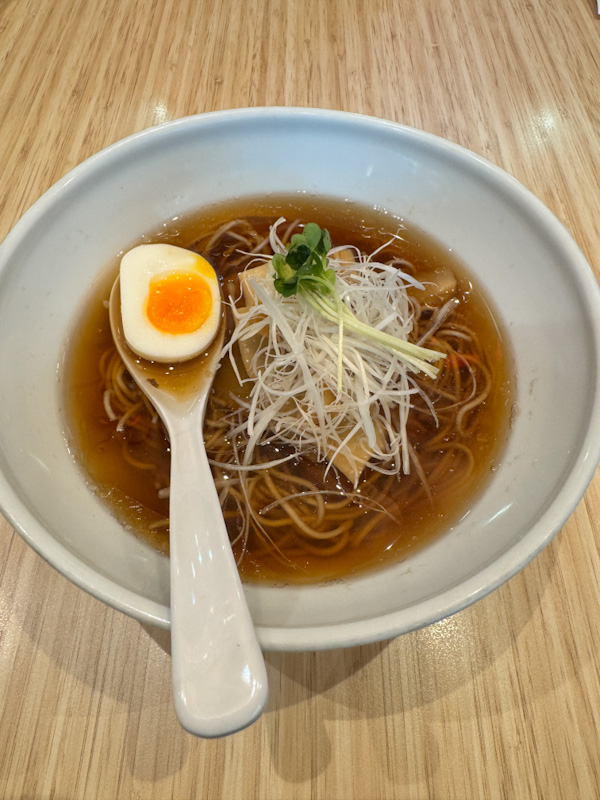
Wadashi Vege Ramen: 60/100
Noodle: 25/35
Thin and straight, these Hakata-style noodles come with a satisfying snappy bite, though the “hard” order landed closer to regular firmness. Still, it’s a decent cook — not underdone, not mushy. There’s an honest whole wheat nuttiness in its taste that complements the broth’s umami direction. It’s the sort of noodle that works best when you want the grain to speak for itself rather than just act as a vessel for soup.
Soup: 30/35
The soup opens with a strong woodsy mushroom aroma, immediately anchoring the bowl in earthy territory. The body unfolds into warm shoyu notes and a savoury umami that feels full-bodied without being heavy. Toward the end, the flavours taper off cleanly, leaving behind a faint shoyu bitterness — subtle, fleeting, but noticeable enough to give it character. There’s depth and layering here, even if the balance teeters slightly toward the earthy rather than the rounded.
Meat: 0/20
Here, “meat” takes the form of two large porcini mushroom stems — ambitious, but unfortunately misguided. They look beautifully grilled, yet the texture tells a different story: tough, dry, stringy, and fibrous. The chew borders on punishing, stripping away the pleasure of what should have been a flavourful centrepiece. The earthy aroma of the porcini is potent, almost too much so, overwhelming rather than harmonising with the broth. The intended smokiness never quite surfaces, leaving the dish feeling unfinished and uneven.
Other Toppings: 5/10
- The bamboo shoots stand out for their unusual but satisfying fruity-sour sweetness, though some pieces verge on too fibrous to enjoy.
- Shiranegi brings gentle piquancy and juiciness that helps brighten the otherwise dark-toned bowl.
- Pea sprouts contribute a light vegetal freshness, offering brief relief from the heavier notes.
- The marinated egg is a redeeming factor — runny yolk, savoury-sweet marination, and balanced umami. It’s well-executed but can only do so much to offset the missteps elsewhere.
Summary
The Wadashi Vege Ramen deserves credit for trying to craft depth without relying on meat, but it suffers from overcommitment to its earthy elements. While the broth shows promise, the textural issues with the porcini turn what could have been a meditative bowl into an uphill chew. A thoughtful idea, but one that feels more conceptual than comforting.

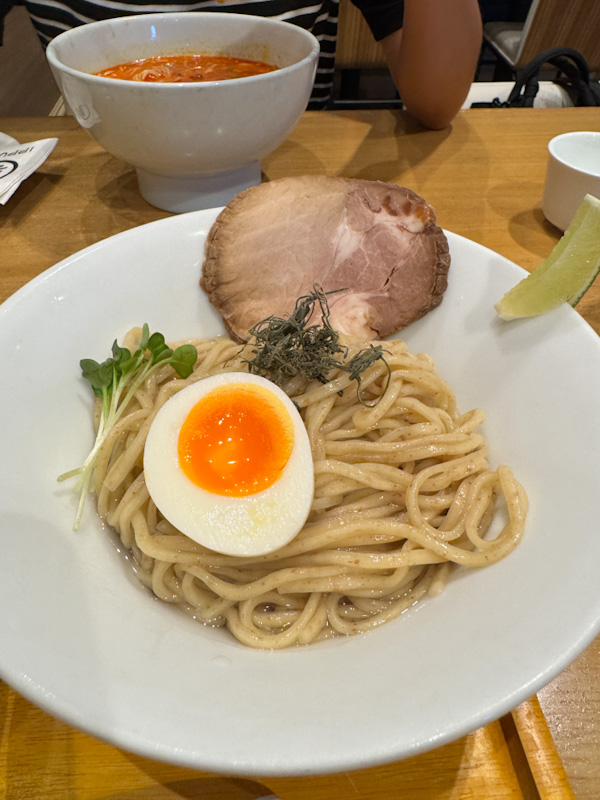

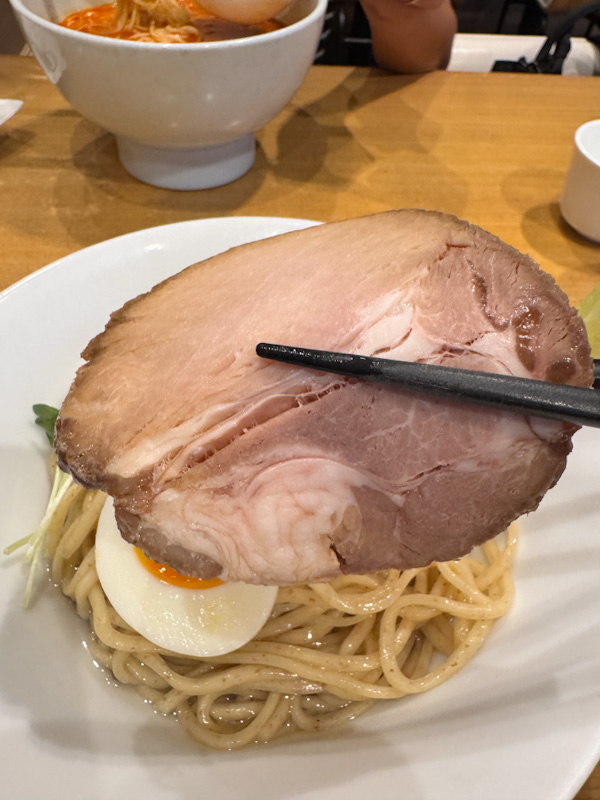
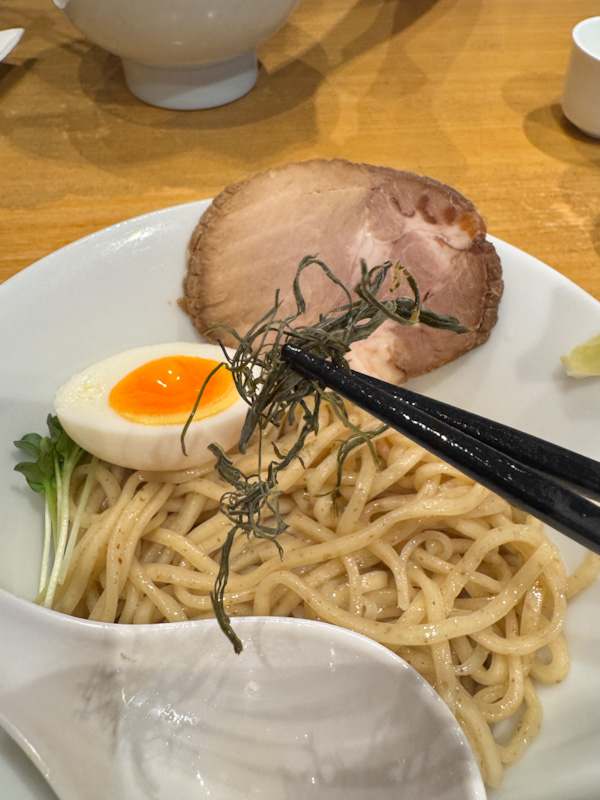
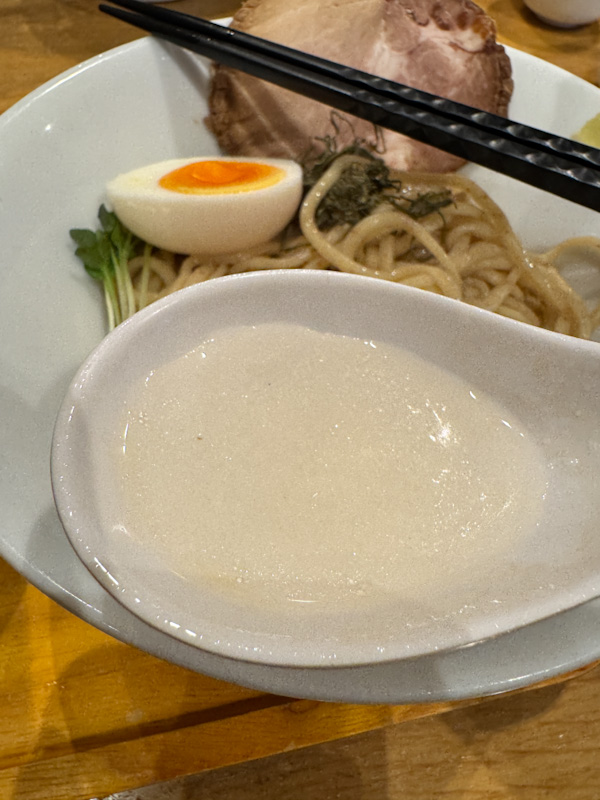
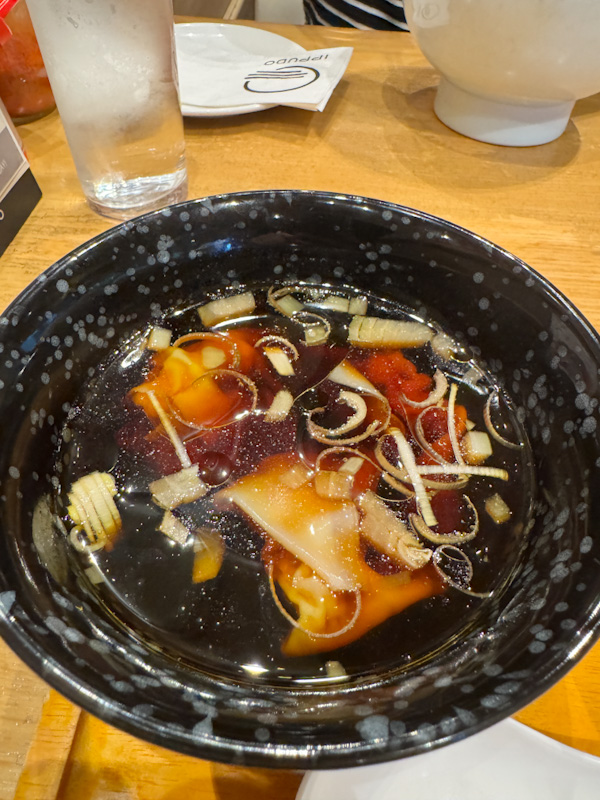

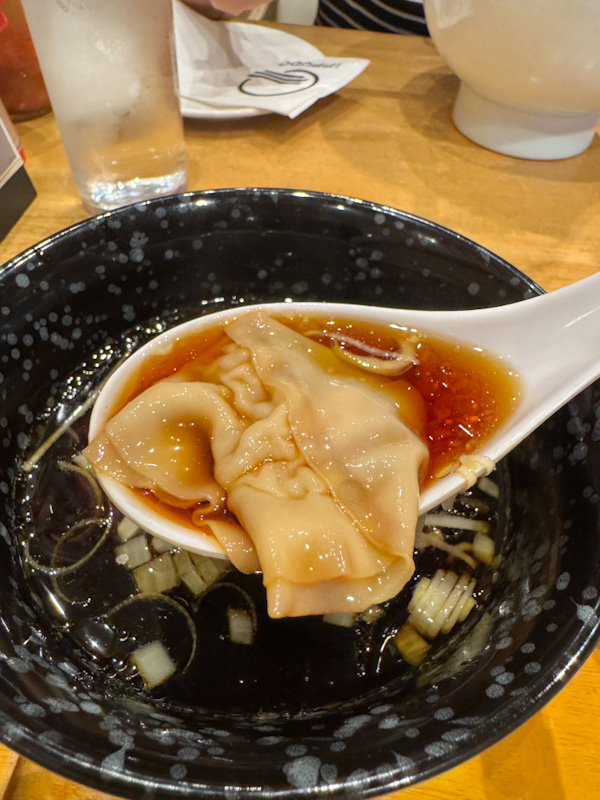

Kombu Sui Tsukemen: 80/100
Noodle: 25/35
The noodles are medium thick, pale yellow with specks of brown that hint at wholegrain flour. Texturally, they deliver a strong mochi mochi chew—dense, firm, and satisfying. The flavour is subtle, leaning towards natural wheat notes with a faint eggy undertone. It’s a noodle that works more as a clean canvas, designed to pair well with the gentle konbu flavours. While enjoyable, I did wish for a little more depth in flavour or aroma on its own.
Soup: 30/35
This tsukemen is served with a twist—kombu sui, or kelp-flavoured water, replaces the usual rich hot broth. The cold kelp broth is clean, light, and elegant—meant to accentuate the noodles rather than dominate. It lets you taste the noodle’s base flavour with a delicate touch of umami.
Then there’s the scallion-kelp dipping sauce, which is richer and more assertive. It has a rounded savoury profile, a quiet but distinct sweetness, and a whisper of shoyu that surfaces at the end.
A final touch: squeeze some lime over the noodles midway through to refresh your palate. That soft tangy lift really brightens the overall flavour and makes it feel like a perfectly layered summer dish.
Meat: 15/20
Two types of protein here:
- A thick slab of chashu—salty, savoury, and solid. It’s got a bit more chew than ideal, but the fat is soft and jelly-like, helping balance out the tougher lean.
- The prawn wontons are a pleasant surprise. They’re smooth, juicy, and softly packed with a savoury filling that carries hints of ginger. The skins are delicate and not overly doughy—nicely done.
Topping: 10/10
Thoughtful and well-composed:
- Tuft of dried kombu that looks like Kagome Kombu. Offers a fun texture while infusing the meal with umami—chewy like dried cuttlefish at first, then turning soft and kelp-like once soaked.
- Pea sprouts bring a fresh, green vegetal snap that cuts the richness.
- Marinated egg is half-cut with a lovely runny yolk—light on the seasoning, but balances well in this dish.
- Lime wedge gives the whole dish a zesty lift.
- Negi and sweet onions float in the dipping sauce, giving pops of sharpness as they get caught in the noodles
Summary
The noodles are well-crafted, and the dual-dip soup is not something you find often outside of Japan. The refreshing taste also makes this a great summer dish that leans clean and umami-forward rather than the typical heavy and rich.

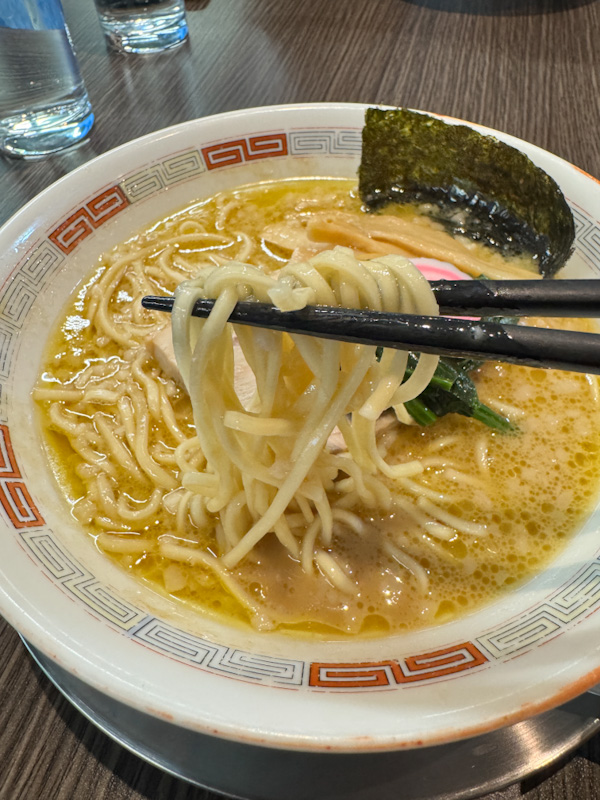

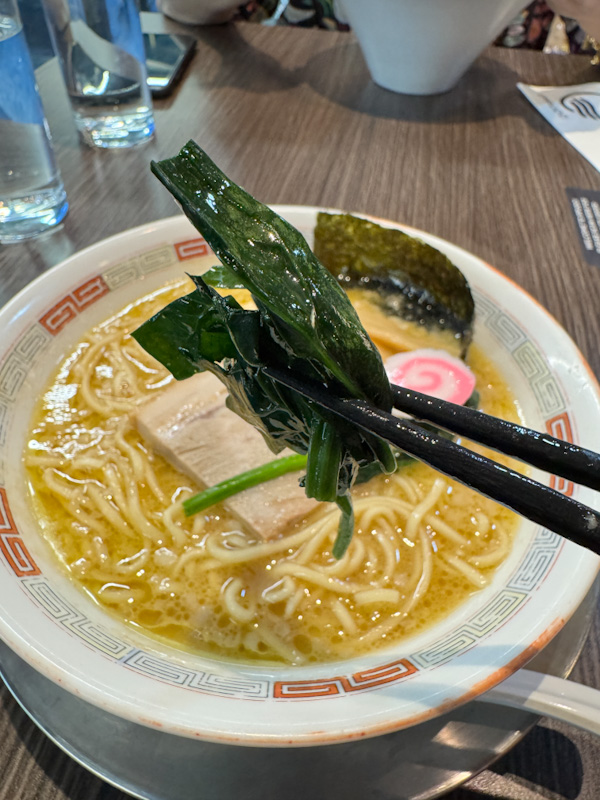
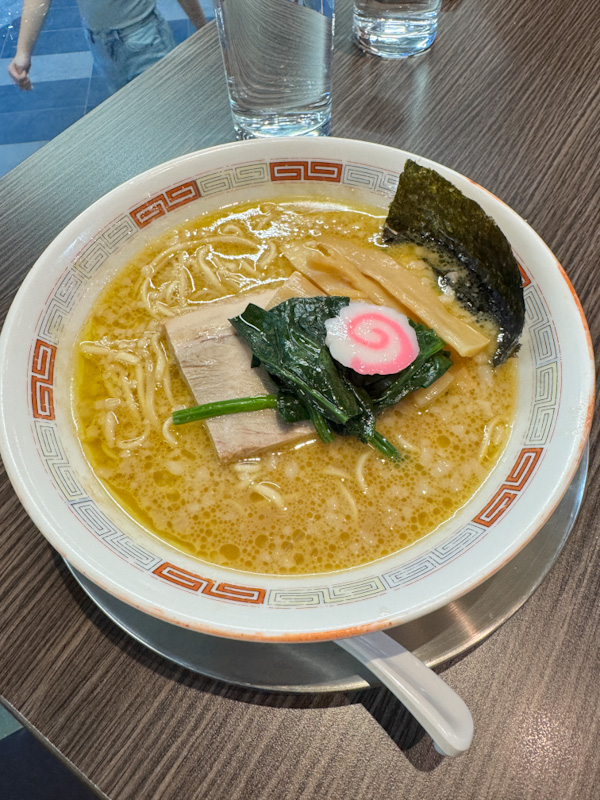
Yokohama Shoyu Ramen: 75/100
A hearty, oil-laden bowl that pays homage to Iekei-style ramen—the working-class favorite born from the streets of Yokohama. While it gets the flavors mostly right, the softer noodles and lighter chashu hold it back from fully capturing the robust, punchy essence that defines this style.
Noodle: 25/35
The noodles are medium thick, firm, and snappy, characteristic of Yokohama ramen. They carry a pleasant wheat flavor but fall short in texture. There’s a slight doughy mouthfeel that’s familiar to the style, but the lack of springiness and firmer bite is noticeable. A subtle kansui aftertaste lingers, which some may appreciate for authenticity, but it’s not as balanced as it could be.
One key issue is the limited choice in firmness—only ‘soft’ and ‘medium’ options are available. For ramen purists who’ve had Yokohama Iekei ramen in Japan, ‘medium’ here simply won’t cut it. Authentic shops often offer ‘hard’ or even ‘wire’ firmness, which delivers that ideal chewy, snappy bite. Unfortunately, local preferences for softer noodles mean this version caters more to general tastes, sacrificing that extra bit of bite that ramen enthusiasts crave.
Soup: 30/35
The hallmark of Iekei ramen is its blend of Tonkotsu and Shoyu, creating a cloudy, rich broth that’s both savory and sweet, with a tangy aroma. This bowl hits those notes well—salty from the Shoyu upfront, followed by the sweet, full-bodied Tonkotsu base and a lingering tanginess. It’s oily, with visible floating pork back fat, adding richness and heartiness to each slurp.
The broth is satisfying and sticks to the bones, living up to its reputation as a working-class meal for truck drivers and laborers. That said, a touch more Shoyu could elevate the complexity further, pushing it closer to the bold, umami-rich versions found in Yokohama’s ramen shops.
Meat: 15/20
The chashu here is a thicker cut of pork belly, more substantial than what you’ll find in Ippudo’s other bowls. The fatty portion melts effortlessly, offering that classic jelly-like texture, while the leaner part provides some chew and fibrous texture.
However, the lean meat isn’t particularly juicy—it straddles the line between dry and tender. While the light seasoning lets the natural pork flavor shine, a more robust marinade could help the chashu stand out against the strong flavors of the broth.
Topping: 5/10
Classic Iekei toppings—seaweed, naruto fish cake, bamboo shoots, and spinach—are present, but they feel more decorative than impactful.
- The bamboo shoots have a nice sweetness but lean slightly fibrous. A bit more tenderness could elevate them
- The spinach is generously portioned and adds a welcome vegetal contrast to the otherwise greasy, heavy bowl.
- Seaweed and naruto, while traditional, don’t contribute much beyond aesthetics.
Summary
This bowl of Yokohama ramen offers a glimpse into the Iekei style’s hearty, rich flavors but holds back in areas that could’ve made it exceptional. The softer noodles and understated toppings keep it comforting but not boundary-pushing. A good bowl for those seeking something heavier and oilier, but ramen purists might crave more punch and textural contrast.


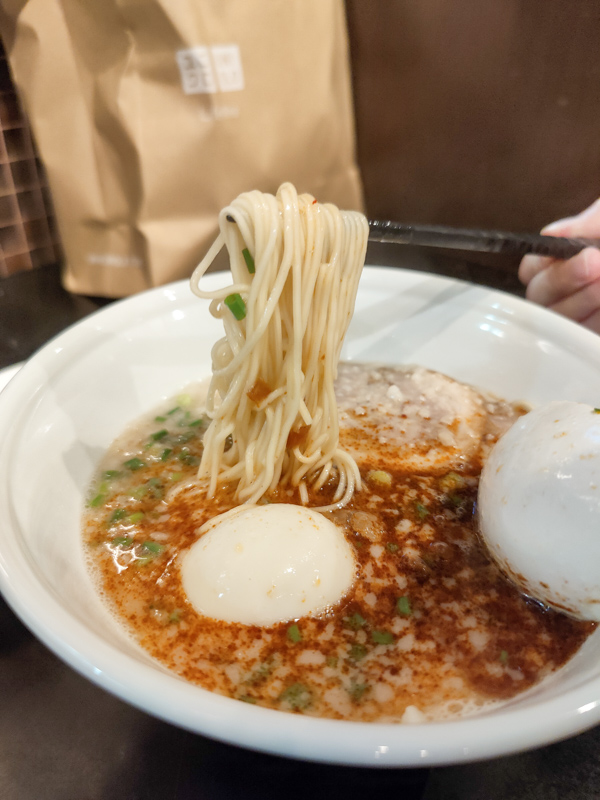




Karaka-men: 80/100
Noodle: 30/35
When it comes to noodles, Ippudo has consistently impressed us over the years. As devoted patrons, we have frequented Ippudo approximately once a month for the past decade, except during lockdown periods when we resorted to their convenient delivery service. Ippudo’s noodles are renowned for their exceptional quality and texture. They are long, thin, and perfect for slurping. What sets them apart is their ability to flawlessly accommodate our “hard and soft noodle” preferences.
Soup: 25/35
Among the array of options we have explored at Ippudo, our favorite is the Karaka-men. Having sampled nearly everything on their menu (although not all experiences are documented, as we have been loyal patrons since their inception), we can confidently say that the broth is a masterpiece. It boasts complexity and depth, combining savory, sweet, and nutty flavors in perfect harmony. Surprisingly, the Singapore Mandarin Gallery outlet offers the most exceptional balance we have ever encountered, surpassing even our experiences in Japan and other Ippudo locations worldwide.
Update from revisit: The broth seems to have deviated from its previously more nutty-sweet flavours. After trying it at a few outlets, it seems consistent that the recipe changed (or perhaps our tastebuds changed). It a bit more hollow, flat-spicy now.
Meat: 15/20
In a similar vein, the meat at Ippudo Mandarin Gallery presents a tantalizing difference. It delivers a melt-in-your-mouth sensation that epitomizes culinary bliss. During our recent visit on December 10th, we observed that the chashu slices had increased in thickness, although they were slightly less tender than on our previous visit. Nonetheless, they still exceeded our expectations in terms of taste and quality.
Update from revisit: Similarly, the meat quality and quantity has dipped. It’s not as tender these days.
Toppings: 10/10
We must reiterate our satisfaction with Ippudo’s Tamago. These eggs possess a distinctive quality, lacking the typical brown tinge on the outside. The delectable running yolk is precisely what one anticipates from a renowned ramen chain. As you savor each bite and delve deeper into the bowl, you may encounter delightful surprises. Sometimes, we discover tantalizing morsels resembling peanuts, while on other occasions, we encounter delectable chunks of onion. The blend of spices and chili used in the toppings offers a remarkable and unforgettable taste, evoking memories with every spoonful. It remains uncertain whether it draws inspiration from Sichuan cuisine or other sources, but regardless, its uniqueness leaves a lasting impression. Prepare to savor every last drop of broth and find yourself instinctively licking the bowl clean.
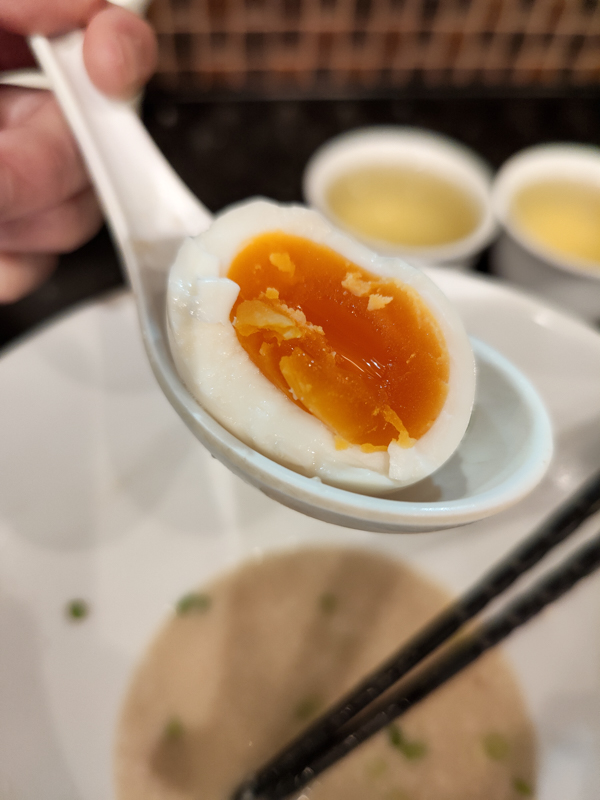

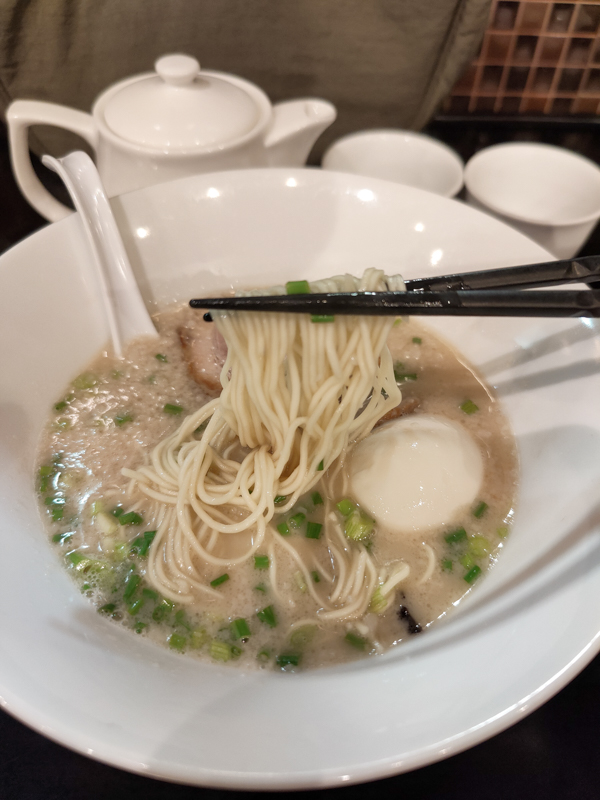
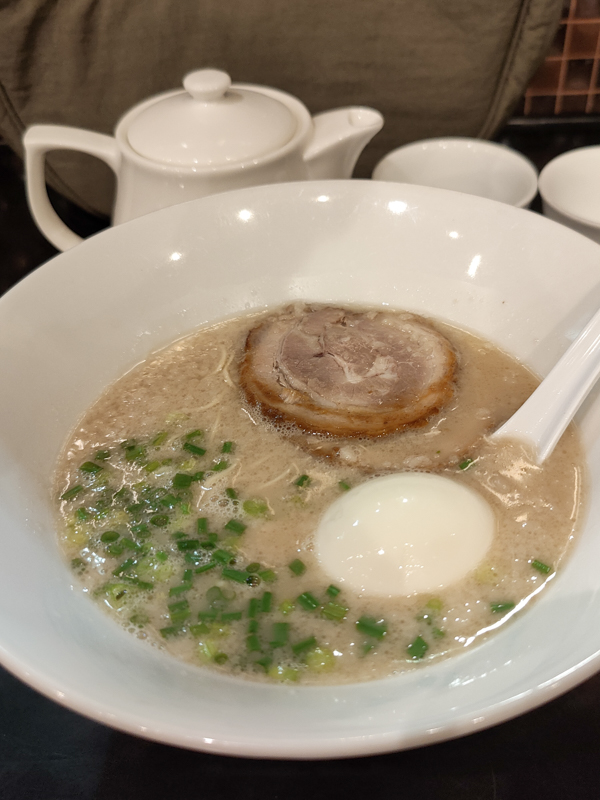

SHIROMARU MOTOAJI: 85/100
Noodle: 30/25
Ippudo’s noodles are long, thin, and perfect for slurping. They consistently deliver the best quality, meeting our “hard and soft noodle” requests flawlessly. Over the past 10 years, we have frequented Ippudo on a monthly basis, enjoying their exceptional noodles that offer an unbeatable texture and flavor.
Soup: 30/35
While some may find the broth slightly watery, its richness becomes evident from the very first sip. The fragrance, savory notes, and umami-packed flavor make it an irresistible treat. Every drop is worth savoring, though we do notice slight differences compared to the previous version of Ippudo’s broth. It used to have a thicker consistency, occasionally showcasing a delicate foam and leaving a delightful stickiness on the lips. Our experiences at various Ippudo locations across Japan reveal a more standardized quality control, and although the current broth may differ slightly, it remains remarkably satisfying.
Meat: 20/20
At the Shaw outlet, we found the Chashu meat disappointingly paper-thin and lacking in flavor (visible in the photos on this page). However, during our recent revisit to the Mandarin Gallery outlet, we were pleasantly surprised by the improved meat quality. The Chashu at Ippudo Mandarin Gallery is nothing short of exceptional, surpassing our expectations. It boasts the perfect thickness, offering a firm texture when handled with utensils, yet effortlessly melts in your mouth. We reminisced about Ippudo’s renowned pork buns, which used to deliver the same level of excellence. While the Chashu in the ramen seemed to have changed over the years, we were delighted to rediscover that exceptional standard at Ippudo Mandarin Gallery.
Toppings: 5/10
Ippudo’s Tamago stands out among the few that lack a brown tinge on the outside. Its perfectly cooked egg with a runny yolk embodies the quality one expects from a reputable ramen chain. The absence of the mirin taste, which was once present at the other outlet, is not an issue here. However, the remaining ingredients in the ramen are ordinary and fail to elicit excitement.
Note: It’s worth highlighting that Ippudo is a renowned ramen chain known for its exceptional noodles, flavorful broth, and delectable Chashu meat. The Tamago and other toppings, although not extraordinary, maintain the high standards expected from Ippudo.

AKAMARU SHINAJI: 70/100
Noodle: 30/35
At Ippudo, the noodles have consistently ranked among the best in our book. As dedicated patrons, we have frequented Ippudo an average of once a month for the past decade, with the exception of lockdown periods. Even during those challenging times, we relied on Ippudo’s delivery service, ensuring our cravings were satisfied every few months. The noodles themselves are long, thin, and expertly crafted for optimal slurping. They stand out from the competition by successfully fulfilling our unique “hard and soft noodle” preferences.
Soup: 30/35
While some may perceive the broth as slightly watery, its richness becomes evident from the very first sip. The alluring aroma of garlic, combined with the savory and umami-packed broth, entices you to savor every last drop. It is worth noting, however, that we have observed a decline in quality over the years. The broth used to boast a more pronounced richness, thickness, and occasional foamy texture, leaving a delightful stickiness on the lips. Additionally, a thin layer of collagen would solidify at the surface, adding a touch of indulgence to the experience.
Meat: 5/20
Thinly sliced and average in taste, the meat leaves much to be desired. We must emphasize that this assessment is based on our experience at the Shaw outlet.
Toppings: 5/10
Ippudo’s Tamago stands out as one of the rare few that lacks the characteristic brown tinge on the outside. The luscious, runny yolk and overall quality are precisely what one expects from a reputable ramen chain. Personally, we found the Mirin aftertaste to be slightly overpowering. As for the remaining ingredients in the ramen, they are passable but fail to deliver any standout flavors worth celebrating.


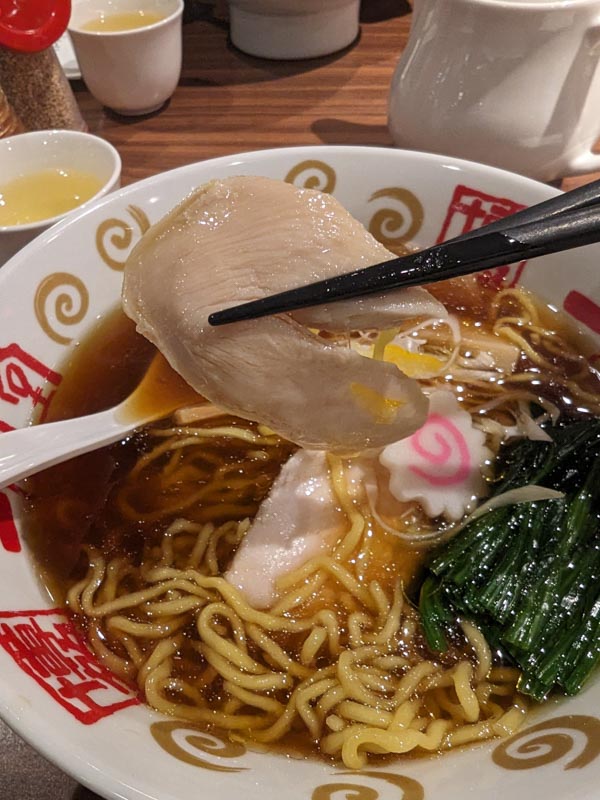
Shoyu Ramen: 60/100
Noodle: 25/35
The noodles are medium-thick, curly, and oblong, holding a firm al dente bite with a dense, satisfying mouthfeel. They carry a pleasant wheat aroma, but the kansui presence is faintly perceptible — just enough to edge into the flavour profile without being aggressive. Texture-wise, they perform well, maintaining springiness throughout the bowl, though the overall balance leans more functional than expressive.
Broth: 25/35
The chicken-based shoyu broth opens with a strong, savoury aroma that immediately signals depth. The head brings a gentle sweetness before easing into a clean, refreshing shoyu body. Towards the end, a faint tanginess and citrusy lift adds a refreshing finish, preventing the broth from feeling heavy. While cohesive, the layers here feel somewhat restrained — the broth is pleasant but lacks the kind of lingering resonance that defines a truly memorable shoyu.
Meat: 5/20
The chicken chashu delivers a slightly springy, slightly bouncy mouthfeel, but little else. The seasoning is too subtle, and the cut lacks the savoury complexity or aromatic lift that might tie it into the broth. It sits in the bowl as a polite participant rather than a defining feature — edible, but emotionally flat.
Toppings: 5/10
The bowl comes with mild vegetables and a standard fishcake, both adding texture but minimal flavour. The standout element is the lemon zest, which brings a brief burst of freshness that brightens the shoyu base. It’s a welcome detail that gives the ramen a lighter touch, though the toppings overall remain somewhat perfunctory.
Summary
Ippudo’s Shoyu Ramen is clean, straightforward, and technically sound — a bowl that plays within safe boundaries. The noodles and broth are well-made but predictable, and while the citrus lift adds a pleasant note, it never quite transcends familiarity. It’s an agreeable everyday ramen, but not one that leaves an impression after the last sip.

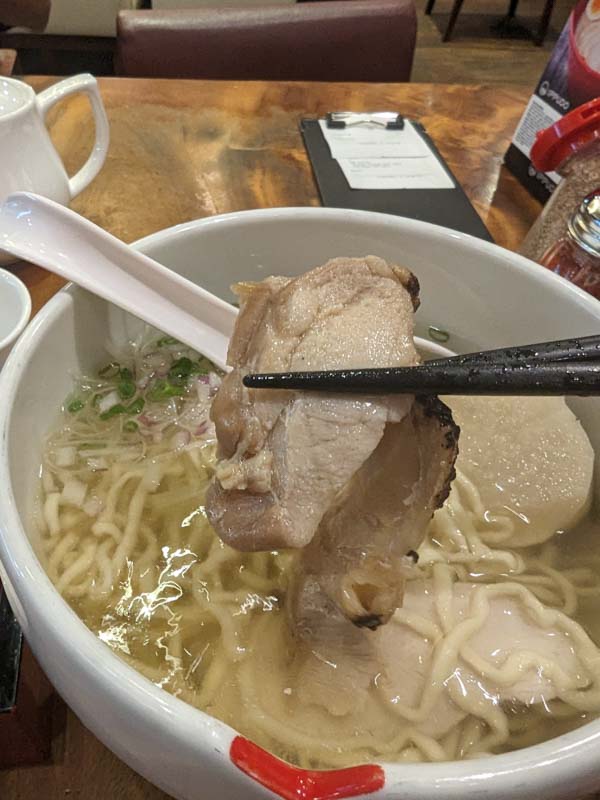

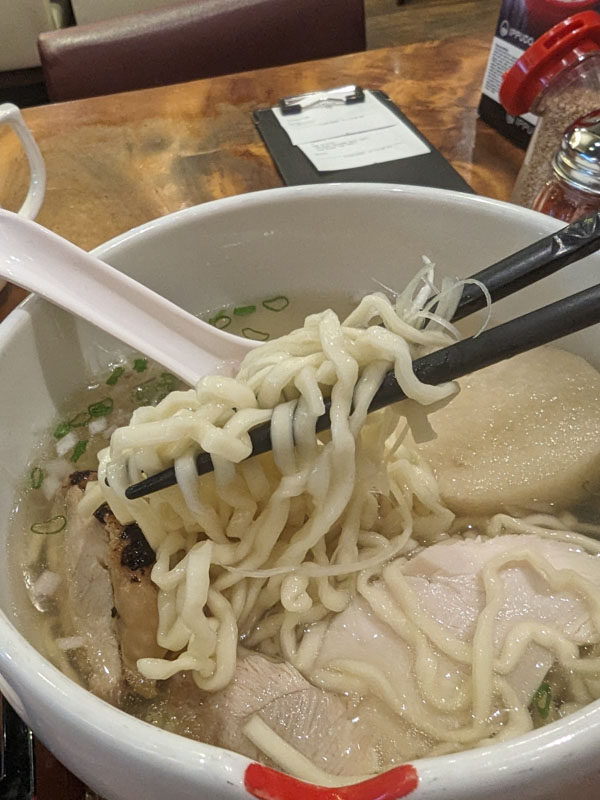

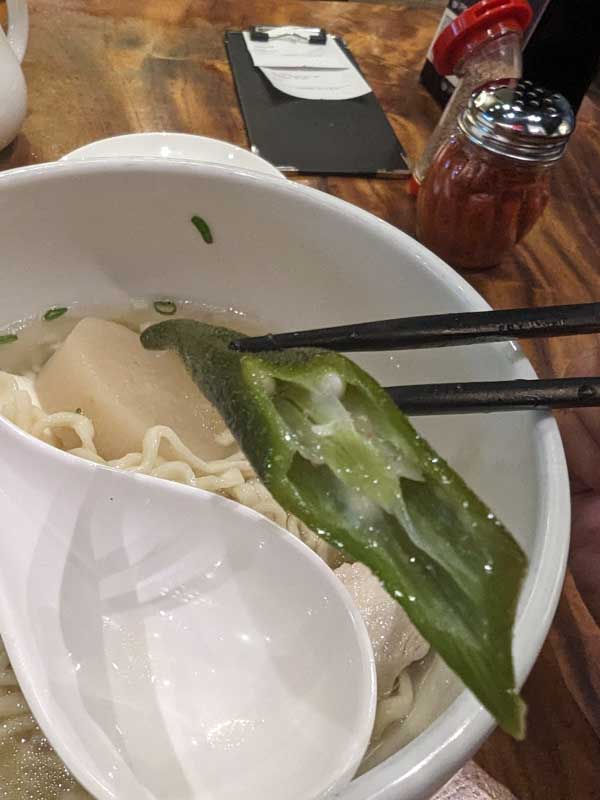
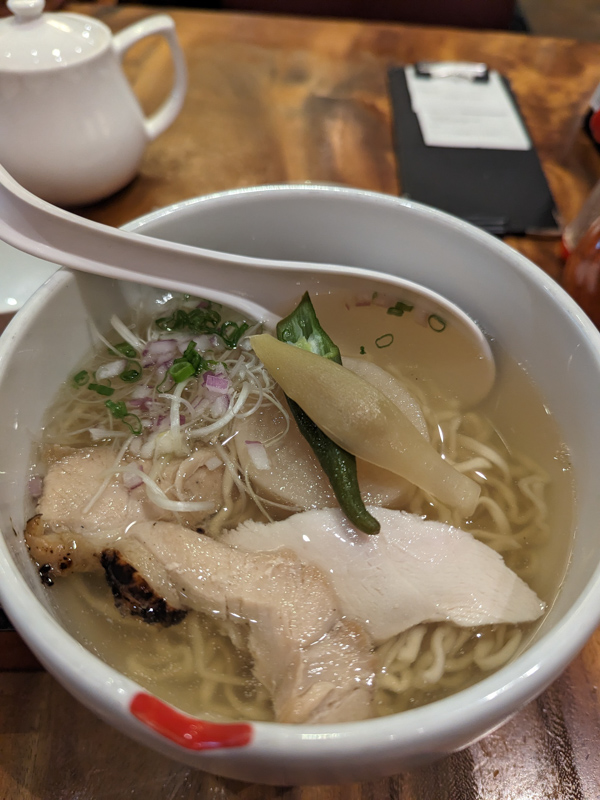
Yaki Ago Dashi – 65/100
This unique ramen experience offers a whirlwind of flavors, textures, and sensations. From the thick and curly noodles reminiscent of childhood favorites to the well-balanced soup with its fishy undertones, sweet notes, and subtle hints of daikon, each spoonful is an adventure for the taste buds. While the chicken chashu could benefit from tenderness improvement, the chewy skin provides an interesting textural element. As you explore the various toppings, the soft and tender okra steals the show, while the onion toppings leave room for improvement.
Noodles: 25/35
The first thing that catches your attention is the thick and curly noodles, reminiscent of everyone’s favorite instant noodle, Maggi. The noodles boast a noticeable wheat flavor, accompanied by the characteristic presence of kansui, a vital ingredient in ramen preparation. The texture is slightly chewy, allowing for a satisfying bite with each slurp.
Soup: 25/35
The soup takes center stage with its well-managed fishy undertones, skillfully balanced with a pleasant sweetness and savory essence. As you savor each spoonful, the taste of daikon adds a refreshing touch, while the umami notes derived from the fish elevate the overall profile. The flavors blend harmoniously, creating a memorable and delightful experience.
Meat: 10/20
The meat component presents itself in the form of succulent chicken chashu. While the mirin taste adds a subtle hint of sweetness, the meat itself tends to be slightly tougher than expected. However, the chewy skin offers a satisfying texture contrast, contributing to an intriguing interplay of flavors and sensations.
Toppings: 5/10
Among the array of toppings, the standout star is the delectable okra. Its soft and tender nature provides a pleasant contrast to the other elements in the bowl. However, the onion toppings may leave something to be desired in terms of flavor, as they lack the desired taste profile. A touch of mustard could have brought an additional layer of excitement to the overall experience.


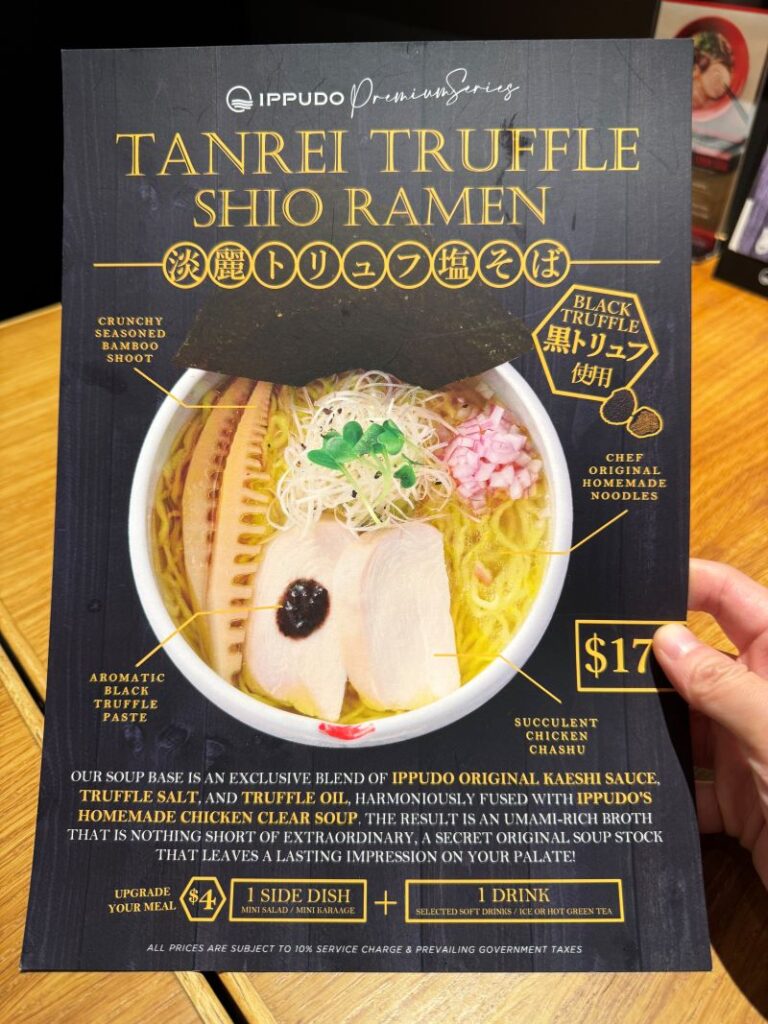

Tanrei Truffle Shio Ramen: 60/100
Noodle: 15/35
The noodles featured in this dish are thick and possess a delightful curl, reminiscent of those commonly found in shoyu ramen. They provide a firm bite with evident density and a slight chewiness. Flavor-wise, a subtle earthy wheat taste prevails. Initially, the bright yellow hue doesn’t betray a pronounced kansui taste (‘yellow noodle’ taste for you fellow Singaporeans), but as the noodles sit in the broth, the kansui flavor gradually takes over the entire soup.
Soup: 25/35
The soup boasts a clear appearance with a noticeable yellow tinge. The truffle aroma is prominent without being overpowering, a departure from the common pitfall of most truffle ramen. It starts with a savory sweet note and integrates a well-balanced truffle aroma that comes and goes with each slurp. While the soup tends toward the lighter side, it leaves a clean palate characteristic of shio ramen. However, as the noodles soak, the kansui taste gradually seeps in, rendering the soup slightly more cloudy and overpowering the initial subtlety.
Meat: 10/20
The chosen meat for this ramen is the chicken chashu, which shares similarities with those used in shoyu ramen. Tender with a hint of gingery aroma, the meat is lightly salted, creating a harmonious balance with the sweetness of the chicken.
Topping: 10/10
The additional toppings, including bamboo shoots, shiranegi, and purple onion, contribute to the overall appeal. The bamboo shoots stand out for their remarkable tenderness and sweetness, a departure from the often borderline pungent typical variety. The subtle aromas from the white shiranegi and purple onion compliments the clean-tasting soup well.
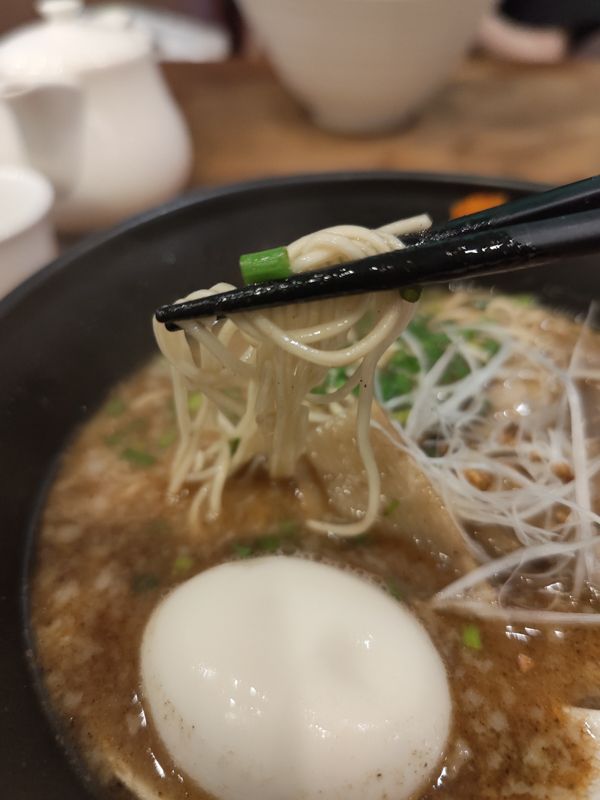
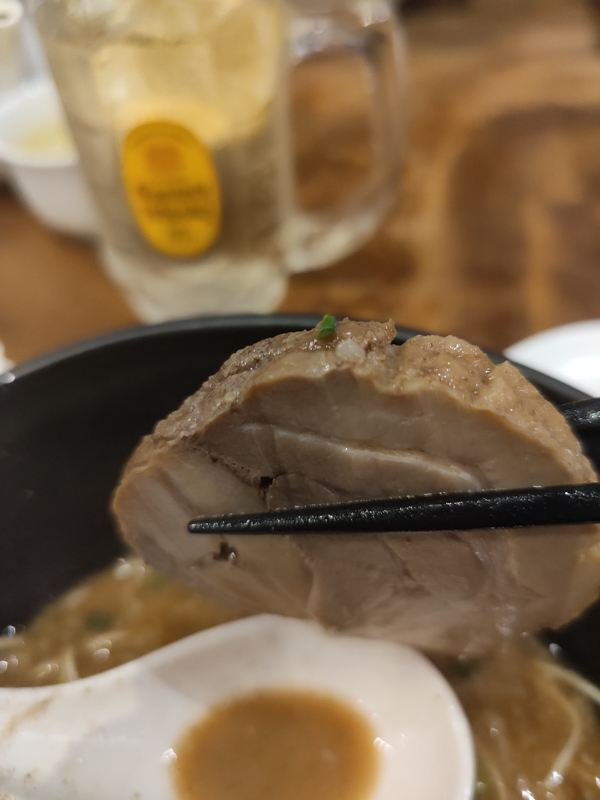


Bonito Tonkotsu Ramen: 90/100
Noodle: 30/35
The noodles used in this ramen are the standard Tonkotsu noodles, providing a satisfying bite and an al dente texture. They effortlessly absorb the flavorful broth, making each slurp a delightful experience.
Soup: 35/35
The soup is a delightful blend of Bonito and Tonkotsu, enriched with floating pork fat for added depth. It bears a resemblance to the KOTTERI SE ABURA RAMEN from Sanpoutei but with a richer and more complex profile. The addition of a red splotch, a Japanese citrus pepper paste, works wonders by infusing the broth with a remarkable mix of umami sweetness, refreshing citrus notes, and a peppery kick at the end. With a brix reading of 10.1, the soup boasts the expected thickness of a classic Tonkotsu, while the salt level leans toward the higher side, likely due to the presence of Bonito.
Meat: 20/20
The meat slices, although slightly uneven in thickness, impress with their tenderness. They offer a savory flavor that is well-balanced and not overly salty, complementing the broth beautifully. The meat’s distinct sweetness sets it apart and adds another layer of enjoyment to the dish.
Toppings: 5/10
The standard Ippudo tamago (egg) makes an appearance, accompanied by bamboo shoots, shironegi (white spring onions), and negi (green onions). While these toppings don’t make a significant impact against the robust broth, they provide a familiar touch to the overall ramen experience.
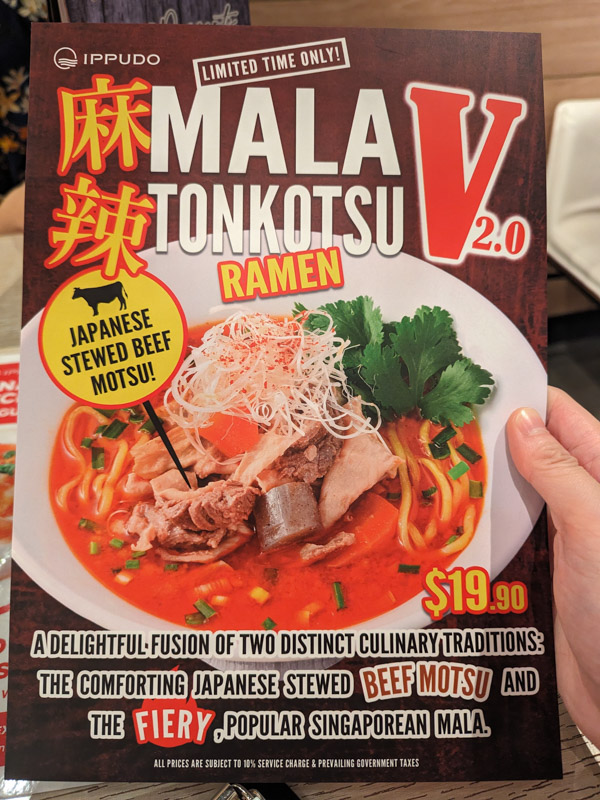


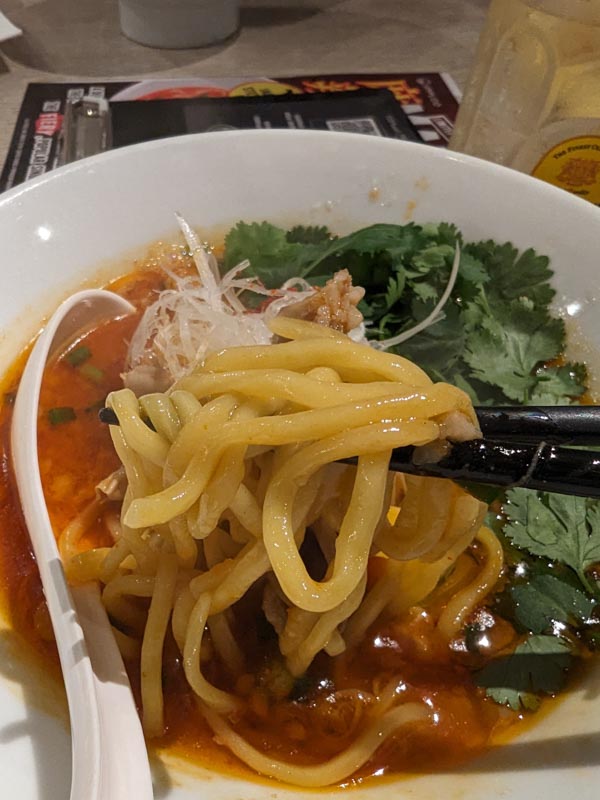
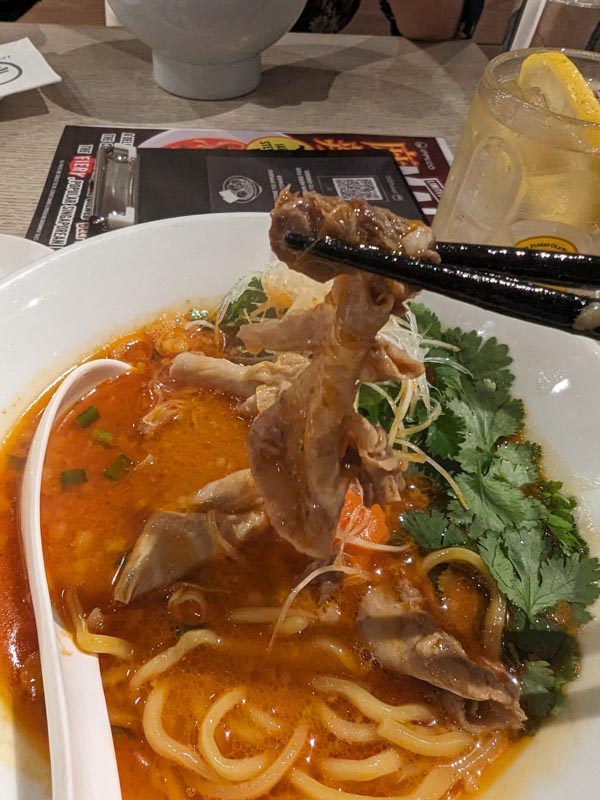

Mala Tonkotsu v2.0 Ramen – 75/100
Noodle: 25/35
The noodles are medium-thick and wavy, giving a firm, chewy bite reminiscent of tsukemen-style texture. Each strand carries a light earthy wheat aroma that surfaces as you chew, anchoring the heat of the soup with a grounded, grainy depth. The chew is substantial without feeling weighty — sturdy enough to stand up to the richness of the broth, yet supple enough to remain enjoyable till the last bite.
Soup: 30/35
The mala tonkotsu broth unfolds in clear stages. It starts assertively — bold, fiery, and unapologetically spicy — before revealing a tangy acidity that cuts through the heat. As the broth settles, a sweet, citrusy note of Sansho pepper rises, leaving behind that distinct tingling numbness across the tongue and lips. It’s an engaging progression of flavours: aggressive yet balanced, familiar yet teasingly unpredictable. The layering here shows thoughtful restraint — a complex broth that entertains without exhausting.
Meat: 10/20
The beef motsu (entrails) is a polarising choice. It delivers a strong, concentrated meaty flavour with hints of deep soy marination, though its chewy, almost rubbery texture demands patience. For those who appreciate offal, it’s rich and rewarding; for others, it may overwhelm. Either way, it makes a statement — one that defines the bowl as much as it divides its audience.
Topping: 10/10
The toppings shine in their generosity and balance. A heap of shiranegi adds sharpness and crunch, while fresh cilantro brings lift and aroma to offset the heavier broth. The inclusion of marinated carrot chunks adds a surprising touch — mild sweetness with just enough texture to contrast the beef motsu. Together, they create a dynamic interplay that grounds the bowl and keeps each mouthful lively.
Summary
Ippudo’s Mala Tonkotsu v2.0 takes the familiar tonkotsu base and infuses it with unapologetic spice and Sichuan flair. It’s a bowl that keeps you guessing from start to finish — fiery, sour, numbing, then sweet. The broth is the star here; the beef motsu, its wild card. Not for the faint of heart, but for those who crave depth and drama in a bowl, this ramen delivers exactly that.
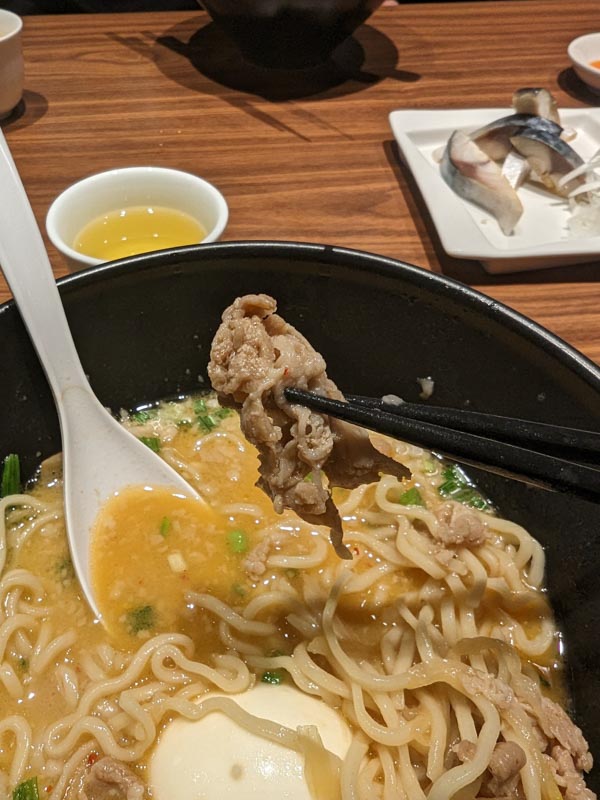
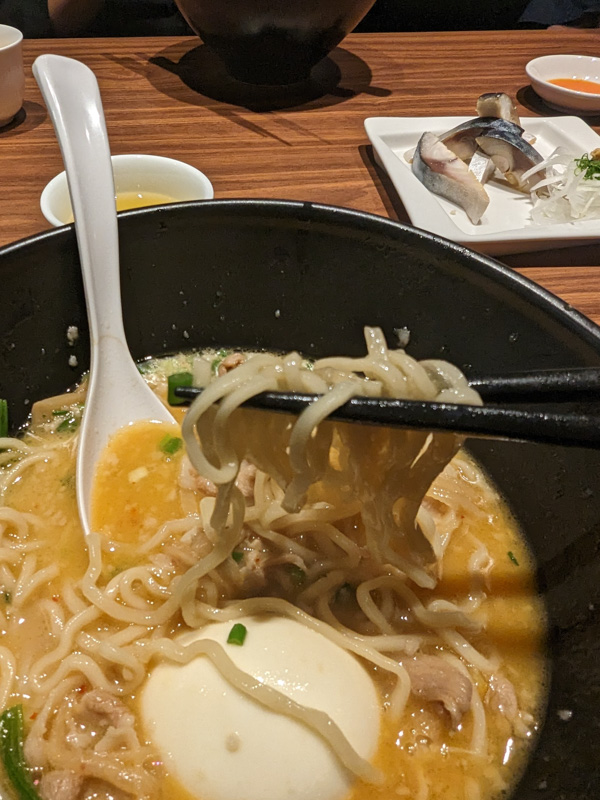
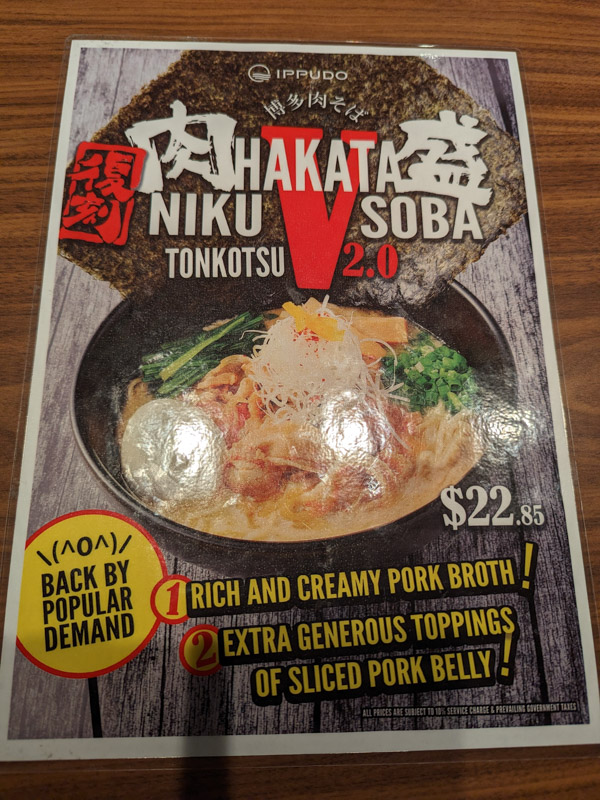

Hakata Nikusoba 2.0 – 70/100
Noodle: 25/35
The noodles are medium-thick and curly, offering a springy, chewy texture that holds up well in the broth. They perform competently, but the flavour profile remains neutral — pleasant yet unremarkable. There’s a steadiness in the bite, though the absence of any distinctive wheat aroma or nuanced finish keeps it from standing out. It’s a serviceable base, but not one that lingers in memory.
Soup: 25/35
The broth leans rich without crossing into creaminess — a balanced tonkotsu profile that opens with gentle sweetness, likely drawn from the simmered meat. This moves into a mild savouriness before giving way to fleeting zesty lemon notes that brighten the palate. Small chili flecks dot the surface, but their presence is more visual than impactful, leaving a missed chance for a stronger spicy counterpoint. Meanwhile, the floating pork fat globules add texture but little discernible flavour. The result is a broth that’s well-structured but somewhat cautious — restrained where it could have been expressive.
Meat: 15/20
The stir-fried pork belly slices are the bowl’s most gratifying element. Tender and well-rendered, they balance lean and fat beautifully. The marination carries both sweetness and savouriness, leaving a soft, lingering umami on the tongue. It’s executed with confidence, elevating an otherwise reserved bowl with moments of genuine satisfaction.
Toppings: 5/10
The tamago is handled deftly — evenly marinated and texturally sound. Supporting players like negi, shiranegi, and bamboo shoots add lightness and crunch, though the bamboo’s slight fibrousness disrupts the flow. Overall, the toppings feel functional rather than inspired — they fill the space but don’t quite build a story.
Summary
Ippudo’s Hakata Nikusoba 2.0 is a study in restraint — clean, measured, and technically sound, but short on flair. The broth plays it safe, the noodles do their job, and the pork belly alone carries most of the bowl’s appeal. It’s a dependable choice, though perhaps too polite for its own good — a ramen that satisfies, but rarely surprises.
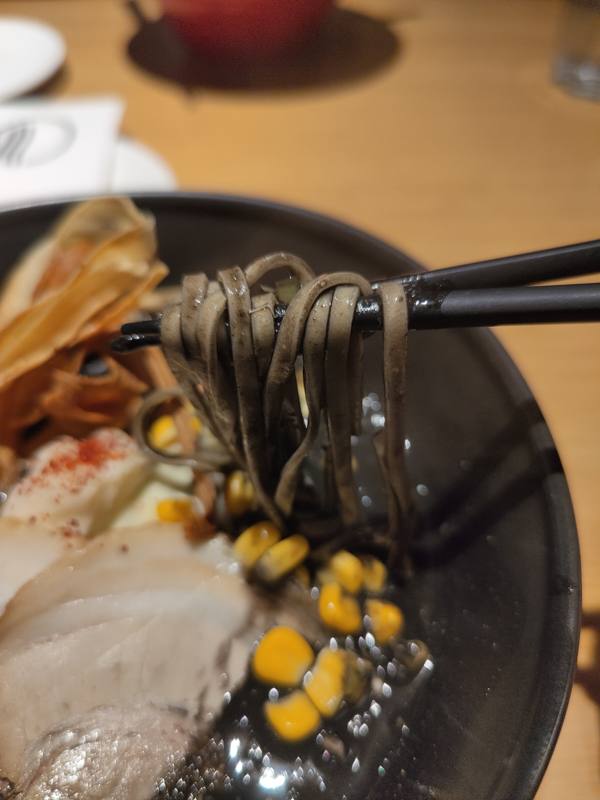

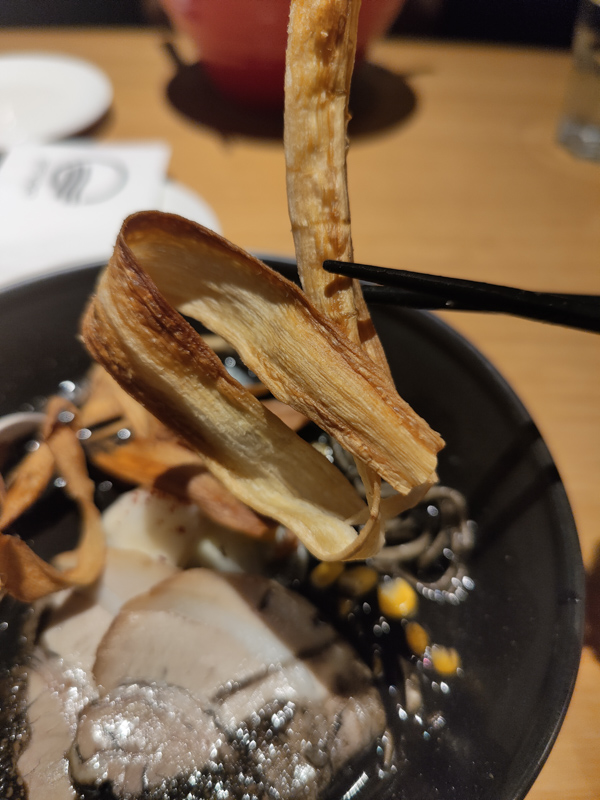
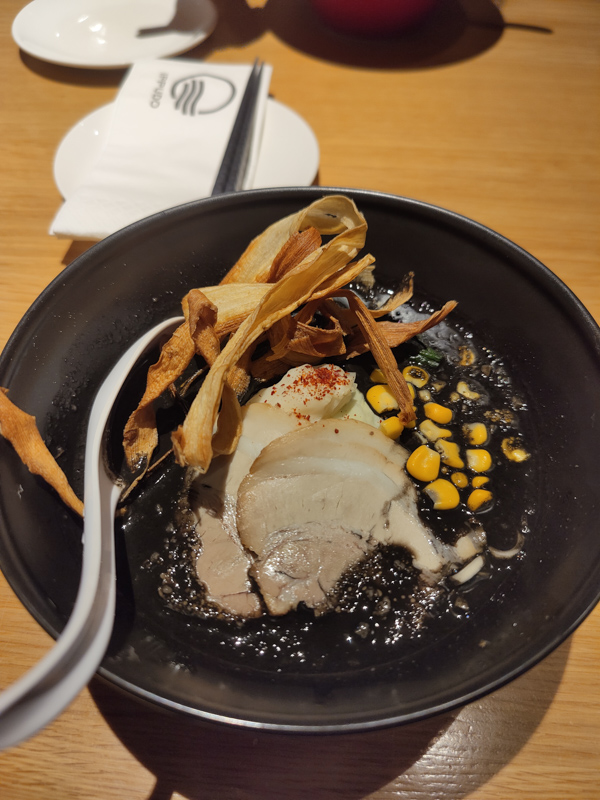
Black Curry Ramen: 70/100
Noodle: 25/35
The noodles used in this ramen are unique, featuring medium-thick, flat strands resembling ‘meepok’ noodles. While the bite of the noodles is satisfactory, they could benefit from a slightly more al dente texture. In terms of taste, they offer a mild springiness that adds to the overall experience.
Soup: 30/35
The broth is a standout element, boasting a thick, rich consistency and an umami-packed profile. It combines a pork and chicken base with squid ink, curry spices, and miso, resulting in a delightful twist on the familiar Japanese curry flavor. Perhaps due to the base or the inclusion of squid ink, there is a subtle savory-sweetness that lingers at the end of each sip, complementing the initial curry notes.
Meat: 5/20
The thinly sliced Chashu at the Shaw outlet tends to be a bit tough and dry, as is often the case. It might be worth revisiting the Mandarin outlet to make a comparison. In terms of taste, it is acceptable but lacks the desired texture.
Toppings: 10/10
The standard Ippudo tamago (egg) makes an appearance, accompanied by a plethora of other toppings including cabbage, sweet corn, spinach, crispy gobo chips (burdock root chips), and chili flakes. While the cabbage and spinach contribute some texture to the meal, their impact is not particularly significant. However, the gobo chips and sweet corn enhance the overall experience with their distinct sweetness, adding layers of flavor to the dish.

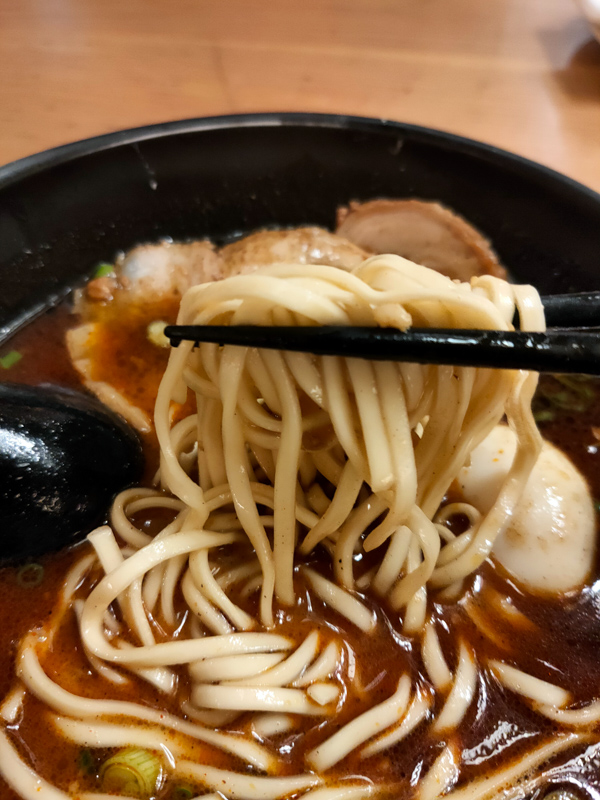
Kuro Ramen: 70/100
Noodle: 30/35
Ippudo’s noodle offering here is a departure from the norm, setting itself apart from other dishes on the menu. These thick, flat noodles bear a striking resemblance to a thinner version of our beloved local ‘meepok’. Their unique texture complements the robust broth exceptionally well, creating a harmonious blend of flavors.
Soup: 30/35
Occasionally, foreign restaurants attempt to cater to local palates by introducing “Singapore exclusives” that often fall short of expectations. However, Ippudo’s endeavor is a pleasant surprise. From the first sip, you can discern the effort put into infusing Singaporean flavors into their ramen. While it retains its Japanese ramen foundation, subtle hints of curry elevate the dish without overpowering it. The result is a skillful fusion that showcases the best of both worlds.
Meat: 5/20
The thinly sliced meat in Ippudo’s ramen leaves much to be desired, offering an average taste that fails to impress.
Toppings: 5/10
Ippudo’s Tamago stands out as a rarity among its peers, lacking the usual brown tinge on the outside. It delivers the expected appeal of a reputable ramen chain, with a delectably runny yolk that adds richness to the dish. However, some may find the Mirin aftertaste slightly overpowering. As for the other toppings, they are satisfactory but fail to offer any remarkable flavors that warrant special recognition.
Note: Ippudo’s innovative approach to noodles here sets it apart from other dishes on the menu. Their thick, flat noodles bear a resemblance to local ‘meepok’ and complement the robust broth. The restaurant’s foray into Singaporean flavors is a standout, successfully infusing subtle curry hints without overshadowing the traditional Japanese ramen foundation. While the thinly sliced meat and standard toppings leave room for improvement, Ippudo’s Tamago impresses with its distinct qualities, showcasing the expertise expected from a reputable ramen chain.
DISCLAIMER
One man’s meat is another man’s poison.
Find out more about our palettes and how we evaluate our ramen here. 😉

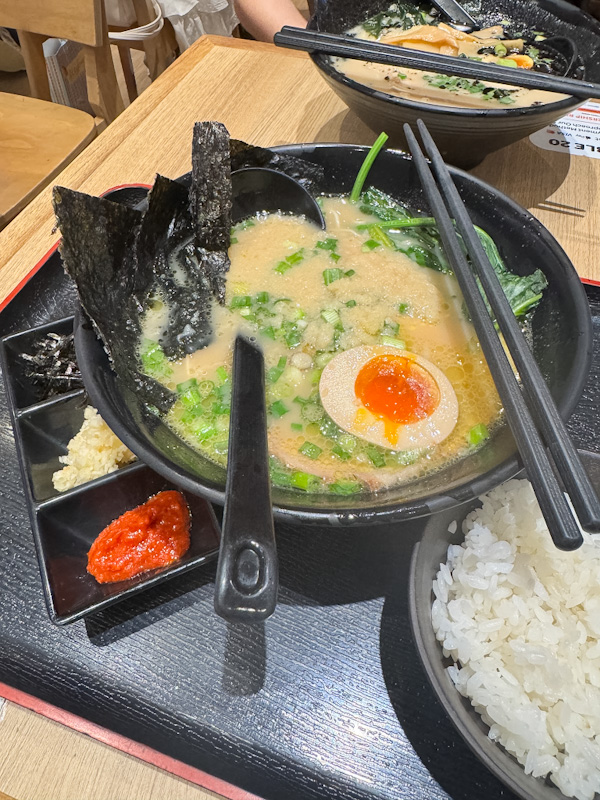
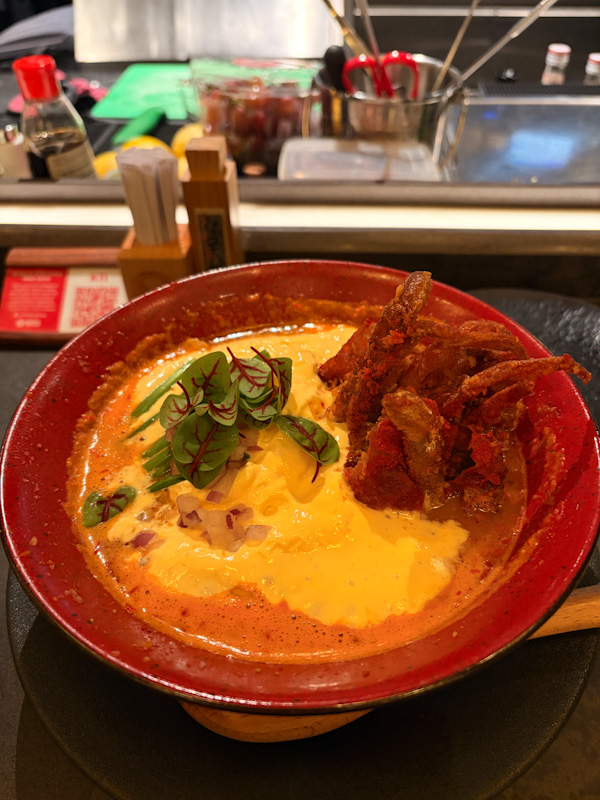
Pingback: Menya Kokoro – 3.75/5.0 – Ah Boy Like Ramen
Pingback: Kanada-ya – Ah Boy Like Ramen
Pingback: Kanada-ya
Pingback: Review of Menya Kokoro
Pingback: Review Of Tsuta Japanese Soba Noodle
Pingback: Review of Konjiki Hototogisu
Pingback: Review of Nantsuttei Ramen